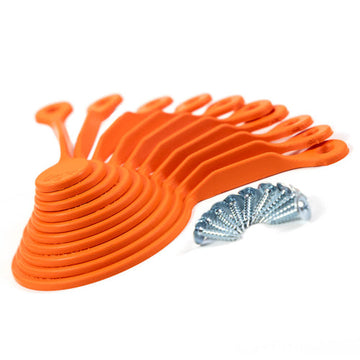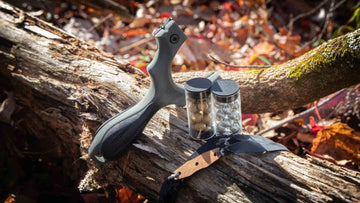A slingshot frame might look simple, but every curve and edge is built purposefully. Understanding how forks, handles, and sight lines work together can completely transform your accuracy, comfort, and shooting consistency. Pair this knowledge with an understanding of the different types of slingshots, and you’ll be able to choose a frame that perfectly matches your shooting style and goals.
Fork Design And Geometry
Fork height and spacing play a big role in how a slingshot feels to shoot. Lower forks often reduce wrist strain, making them easier to manage for longer sessions. Higher forks can create more leverage on the grip, which some new shooters actually find reassuring since the projectile feels farther from the hand. Attachment style also matters: OTT (Over-the-Top) positions the band higher on the fork, while TTF (Through-the-Fork) sits lower, closer to the hand. Some modern frames even let you adjust the fork gap to fine-tune comfort and performance to your shooting style.
Handle Shape And Grip Comfort
A good handle isn’t just about how it feels; it builds muscle memory and repeatability. Materials matter, too: heavier builds like G10 or aluminum provide stability and vibration control, while lighter frames are perfect for those who value portability and everyday carry convenience.
Sight Lines And Aiming Cues
Sight lines are the unsung heroes of precision shooting. Subtle fork markings, raised guides, or contrasting colors provide visual cues without breaking your shooting rhythm. Many modern frames — including SimpleShot’s newer models, such as the Scout LT2 and Axiom — now feature built-in fiber optic reference points, giving you a bright, intuitive alignment aid that helps shots feel more natural and accuracy builds faster over time.
Connecting Craft And Performance
When you understand frame anatomy, you’re not just using a slingshot but shaping a personal experience. Every element, from fork geometry to sight alignment, is designed to bring joy, accuracy, and a sense of connection every time you step onto the range or into the backyard.
Choosing The Right Frame Material: Advanced Thermoplastics, G10, Metal, Wood
Your slingshot frame is the foundation of every shot, and the material you choose shapes how it feels, performs, and holds up over time. The right choice sets the tone for your shooting style, accuracy, and overall experience. Pairing the right frame with proper measuring slingshot draw length ensures that your setup matches your power and control goals, giving you the consistency you need shot after shot.
Thermoplastic Frames: Lightweight And Reliable
Thermoplastic frames are a favorite for shooters who value portability and durability. These modern builds balance a light-weight feel with intense durability to make for a versatile tool. They resist swelling in wet weather and remain dependable for everyday carry and casual plinking.
G10 Frames: Dense And Precision-Oriented
For shooters who crave precision, G10 is a go-to material. This fiberglass composite is heavier and provides a solid, stable feel that minimizes wobble during your draw. The extra weight improves shot consistency, making it a favorite among marksmen chasing tight groupings.
Metal Frames: Rugged And Ultra-Stable
Aluminum and stainless steel frames bring unbeatable strength and a cool, tactile feel. Though heavier, metal frames provide exceptional stability and are ideal for long sessions or carefully calculated shots where control and durability matter most.
Wooden Frames: Classic And Organic
Wooden slingshots bring a sense of heritage and individuality; no two are exactly alike. They offer warmth, natural texture, and a timeless connection to slingshot tradition. While they require more care, they reward shooters with unmatched character and tactile satisfaction.
Matching Material To Your Style
Choosing the right frame material isn’t just about specs; it’s about aligning the feel in your hand with the type of shooting you enjoy. Whether you need rugged dependability, precision weight, or classic aesthetics, the frame sets the stage for every memorable shot.
Power up your next shooting session with precision-crafted slingshot parts from SimpleShot. Every component, from frames to bands and pouches, is built for accuracy and durability. Upgrade, customize, and fine-tune your setup today because great shots start with the right gear in your hands.
Pouches: Microfiber Options, Sizes, And Attachment Methods
A well-matched pouch is one of the most overlooked but vital slingshot parts. The right choice can dramatically improve accuracy, consistency, and shooting comfort. Microfiber band pouches have become the modern standard, offering excellent grip, a clean release, and outstanding durability. Pairing your pouch with the right ammo from a slingshot ammo size chart ensures consistent results every time you shoot.
Microfiber Options for Every Shooter
Flat microfiber pouches are the go-to choice for most setups, providing a balanced feel that works well with steel balls. Precision shooters often prefer lighter, thinner microfiber for sensitivity, while hunters and heavy shooters choose thicker, sturdier versions to handle demanding conditions.
Choosing The Right Size
Flat microfiber pouches are the go-to choice for most setups, providing a balanced feel that works well with steel balls. Precision shooters often prefer lighter, thinner microfiber for sensitivity, while hunters and heavy shooters choose thicker, sturdier versions to handle demanding conditions.
Understanding Pouch Thickness
Thinner microfiber enhances connection and feedback, making it ideal for rapid-fire sessions. Thicker microfiber offers added durability and confidence for outdoor shooting, where grit, moisture, and frequent pulls put extra stress on your gear.
Attachment Methods That Work
Traditional wrap-and-tuck methods remain popular for their simplicity and reliability. Modern integrated clip systems, often paired with included hex keys, make swapping pouches quick and secure — perfect for shooters who like to experiment or replace parts on the go.
Fine-Tuning For Your Setup
Experimenting with pouch sizes, microfiber types, and attachment styles helps you find the sweet spot for your shooting style. Each adjustment refines your release, improving accuracy and adding confidence to every shot you take.
Integrated Clips vs FlipClip X™: How Your Bands Attach
Your band attachment system is one of the most critical slingshot parts, because no matter how great your frame or pouch is, the bands power every shot. The way they connect directly impacts performance, consistency, and confidence.
Integrated Clips: Modern Precision
Integrated clips are the new standard for serious shooters. Built directly into the frame, they create a seamless, low-profile attachment system designed for speed and repeatability. Slingshot replacement bands are tightened securely without extra tools or loose hardware using the included hex key. This setup makes swapping between different band sets quick and frustration-free, ensuring every pull feels the same from start to finish.
Performance Benefits Of Integrated Clips
Frames with integrated clips often distribute weight more evenly, improving balance and comfort during longer sessions. This consistency allows shooters to focus on their aim rather than fighting shifting hardware, an invaluable edge for honing accuracy and building repeatable form.
FlipClip X: Yesterday’s Standard
FlipClip X is still loved by many shooters for its rock-solid hold and unmatched strength. It made quick band swaps possible without tools and remains one of the most secure systems for both flat and tube bands. The main drawback is that the clips are a bit bulky and can feel fiddly during installation. As the sport has progressed, integrated clip systems have gained popularity for being slimmer and more seamless with the frame, but nothing has truly replaced the durability and reliability of FlipClip X.
Why Many Shooters Are Moving On
While FlipClip X frames are still serviceable, many enthusiasts now opt for integrated clip systems for their reliability and precision fit. Integrated clips reduce maintenance and remove variables that can reduce shot consistency, which is an upgrade most accuracy-focused shooters find hard to pass up.
Finding The Right Setup For Your Style
Whether you prefer the old-school flexibility of FlipClip X or the no-nonsense efficiency of integrated clips, your choice should match your shooting habits. If you enjoy tinkering often, FlipClip X suits you. If you crave a streamlined, secure setup, integrated clips will feel like a game-changer.
Customizing Fork Gap and Tip Width for Accuracy
Dialing in your setup goes beyond bands or ammo — fork gap and tip width also shape how your slingshot feels and performs. While there are no hard rules, understanding these dimensions can help you fine-tune for comfort and consistency.
- Fork Gap & Its Role In Accuracy: Fork gap is simply the distance between your fork tips. Some shooters prefer a wider gap, others a narrower one, and both can be equally accurate. It comes down to what feels most natural with your anchor point, grip, and ammo choice.
- Tip Width & Band Alignment: Tip width influences how bands sit and release. Slimmer tips keep bands running straighter, which can reduce drag and hand slap with tapered setups. Wider tips give you more surface area for a secure hold, making band swaps or retying easier.
- Configuring Setup For Purpose: Tip width and fork gap ultimately come down to personal preference—there’s no universal “right” or “wrong” dimension. That said, hunters and power shooters often appreciate wider tips because they make it easier to attach wider bands. However, with today’s more advanced latex formulations delivering significantly greater power, wide bands are no longer as essential as they once were.
- Balancing Comfort & Control: The real value in adjusting fork gap and tip width is finding a balance between comfort and control. A natural setup in your hand will ultimately deliver the most consistent results.
- Experimentation Builds Consistency: Minor changes can dramatically shift how a frame feels. Try different combinations until you land on one that matches your grip and shooting style. Over time, these adjustments build muscle memory, leading to steady, repeatable accuracy.
Starter Kit Must-Haves: Everything You Need Out Of The Box
Starting your slingshot journey should feel exciting, not overwhelming. A well-built starter kit ensures you have all the slingshot accessories you need to build confidence, practice safely, and enjoy those first satisfying shots without hunting for extra parts. Joining a slingshot community can also be a huge help, offering encouragement and tips as you learn.
A Durable, Precision Frame
Every great kit starts with a high-quality frame. Look for advanced thermoplastics, like the ones Simpleshot uses, which are known for their strength, comfort, and reliability. The frame should be ergonomic, easy to grip, and versatile enough to suit pinch or hammer grip styles.
Quality Band Sets
Band sets are the power source of your slingshot, and the best starter kits include pre-cut flat bands designed for consistent speed and accuracy. Some kits provide multiple band options, allowing you to experiment with power levels and find your comfort zone.
Leather Pouches For Consistency
A good kit includes premium leather band pouches, which cradle ammo securely and allow smooth releases. Leather offers the ideal balance of grip and flexibility, helping beginners build muscle memory and improve accuracy shot after shot.
Simple Setup And Easy Adjustments
Integrated clip systems or included hex keys make installation frustration-free and straightforward. This lets you focus on learning rather than wrestling with your gear and ensures you can swap bands quickly as you practice or try new setups.
Starter Ammo To Get You Shooting
A proper kit includes a generous pack of clay or steel ammo to let you practice form, experiment with different band setups, and build confidence before buying refills.
Guidance And Tips For Beginners
Some kits include clear user guides or pro tips, giving you a smooth introduction to shooting techniques, safety reminders, and setup adjustments. This extra support makes a big difference when you’re just starting.
Read also:














































































































